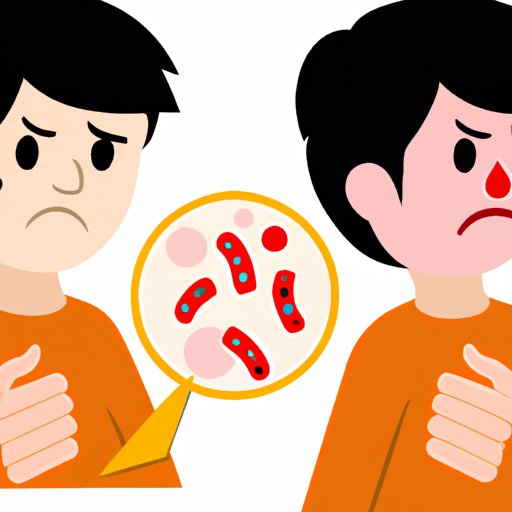
Introduction
Infectious diseases are a global health concern affecting millions of people each year. These illnesses are caused by organisms, including bacteria, viruses, fungi, and parasites, that can spread from person to person or through contaminated objects or environments. The impact of infectious diseases can range from mild illness to severe, life-threatening conditions. In this article, we will explore what causes infectious diseases and how to prevent their spread.
The Invisible Enemy: Understanding the Science Behind Infectious Diseases
A. What are infectious diseases?
Infectious diseases are caused by organisms that can enter the body and cause illness. These organisms can be bacteria, viruses, fungi, or parasites and are often spread from person to person or through contaminated environments.
B. How do they differ from non-infectious diseases?
Non-infectious diseases, such as heart disease and cancer, are caused by factors like genetics, lifestyle, and environmental factors, and are not transmitted from person to person.
C. Factors that make it possible for infectious diseases to spread
Several factors can make it easier for infectious diseases to spread, including close contact with infected people or animals, poor sanitation and hygiene, and crowded living conditions.
D. How infectious diseases are classified
Infectious diseases can be classified in several ways, including by the type of organism that causes them, the mode of transmission, and the part of the body that is affected.

From Coughs to Sneezes: A Comprehensive Overview of How Germs Spread
A. Overview of how germs can spread from one person to another
Germs can spread from one person to another through respiratory droplets, touching contaminated surfaces, or through bodily fluids like blood or semen.
B. Common modes of transmission
Common modes of transmission for infectious diseases include airborne spread, contact transmission, fecal-oral transmission, and vector-borne transmission.
C. Examples of diseases spread through each mode of transmission
Some examples of diseases spread through each mode of transmission include:
- Airborne spread – Influenza, tuberculosis
- Contact transmission – Methicillin-resistant Staphylococcus aureus (MRSA), chickenpox
- Fecal-oral transmission – Norovirus, Hepatitis A
- Vector-borne transmission – Malaria, Lyme disease
Breaking Down the Chain of Infection: The Key Elements of Disease Transmission
A. Introduction to the chain of infection
The chain of infection is a model used to understand how infectious diseases can spread. The chain has several key elements, including the infectious agent, reservoir, portal of exit, mode of transmission, portal of entry, and susceptible host.
B. Explanation of each element
The infectious agent is the microbe that causes the disease, and the reservoir is the place it lives. The portal of exit is where the infectious agent leaves the body, while the mode of transmission is how it is spread to another host. The portal of entry is where the microbe enters the new host, and the susceptible host is the person who is at risk of developing the disease.
C. Examples of diseases that demonstrate each element in the chain
Some examples of diseases that demonstrate each element in the chain of infection include:
- Infectious agent – Streptococcus pyogenes (strep throat)
- Reservoir – Salmonella typhi (typhoid fever)
- Portal of exit – Bordetella pertussis (whooping cough)
- Mode of transmission – Human immunodeficiency virus (HIV)
- Portal of entry – Rabies virus
- Susceptible host – Influenza
The Role of Environmental Factors in the Spread of Infectious Diseases
A. Overview of environmental factors that can contribute to the spread of infectious diseases
Environmental factors, such as poor sanitation, overcrowding, and climate change, can contribute to the spread of infectious diseases.
B. Examples of diseases that are influenced by environmental factors
Some examples of diseases that are influenced by environmental factors include:
- Poor sanitation – Cholera
- Overcrowding – Measles, tuberculosis
- Climate change – Malaria
C. Suggestions for how individuals can help mitigate these factors
Individuals can help mitigate these factors by practicing good hygiene, reducing water waste, and being mindful of their carbon footprint.
Uncovering the Culprits: The Main Agents that Cause Infectious Diseases
A. Overview of the different types of infectious agents
Infectious diseases can be caused by several different types of agents, including bacteria, viruses, parasites, and fungi.
B. Examples of diseases caused by each type of agent
Some examples of diseases caused by each type of agent include:
- Bacteria – Streptococcus pneumoniae (pneumonia)
- Viruses – Influenza virus
- Parasites – Plasmodium falciparum (malaria)
- Fungi – Candida albicans (yeast infections)
C. Explanation of how each type of agent differs in terms of transmission, severity of illness, etc.
Each type of agent differs in terms of transmission, severity of illness, and treatment options. For example, bacteria can be treated with antibiotics, while viruses require antiviral medications. Parasites often require specialized medications and treatments.
Personal Hygiene and Infection Control: Tips on Preventing Disease Spread in Daily Life
A. Explanation of why personal hygiene and infection control are important
Practicing good personal hygiene and infection control can help prevent the spread of infectious diseases, protecting yourself and those around you.
B. Tips for maintaining good personal hygiene
Some tips for maintaining good personal hygiene include:
- Wash hands frequently with soap and water.
- Cover coughs and sneezes with a tissue or elbow crease.
- Stay home when sick.
C. Suggestions for reducing the spread of infectious diseases in public spaces
Some suggestions for reducing the spread of infectious diseases in public spaces including wiping down surfaces, avoiding touching your face, and wearing a mask when appropriate.
Conclusion
Infectious diseases continue to be a significant public health concern. By understanding how these illnesses spread and the importance of infection control, individuals can take steps to help prevent their spread. Practicing good personal hygiene, being mindful of environmental factors, and staying informed can all play important roles in promoting public health and safety.




